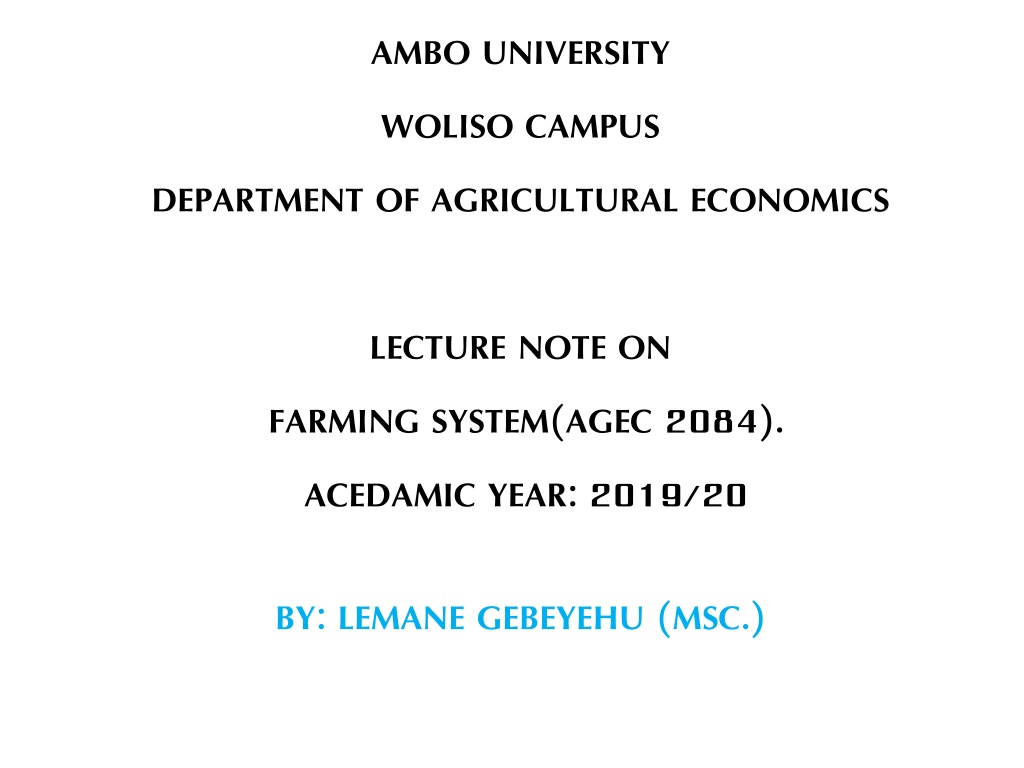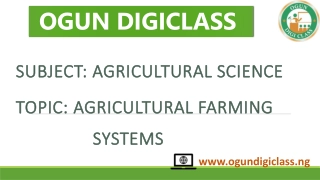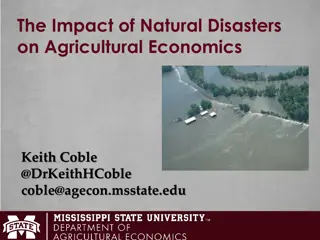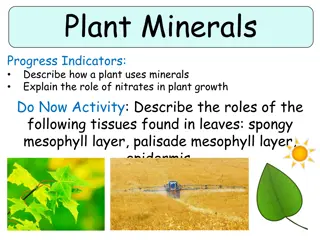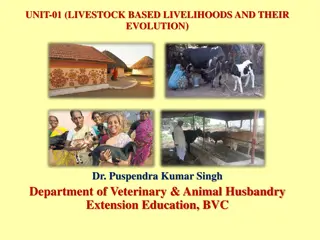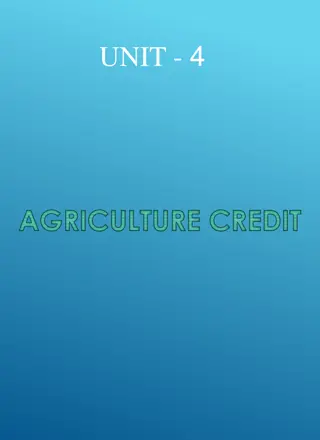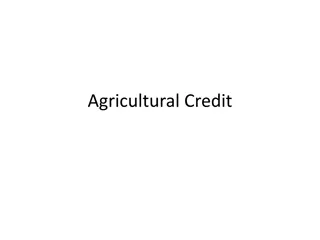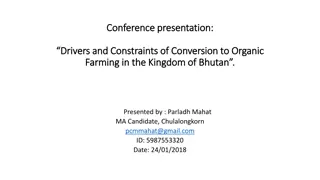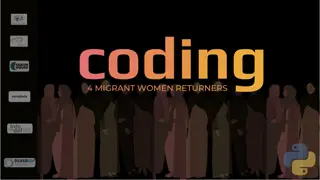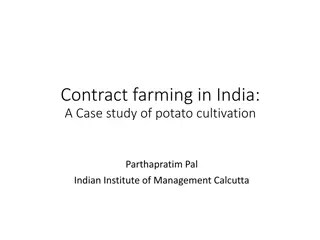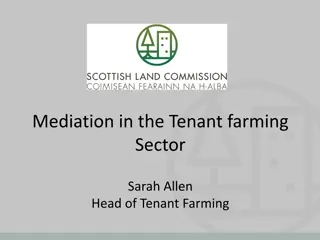Understanding Farming Systems in Agricultural Economics
Concepts of farming systems research and development are crucial for effective agricultural management. A farming system encompasses various components that work together to achieve specific objectives. It involves the arrangement and management of farming enterprises in response to environmental factors, such as rainfall, soil characteristics, and socio-economic conditions. By understanding the interconnectedness of these components, farmers can address challenges more efficiently and optimize production processes.
- Farming Systems
- Agricultural Economics
- Research and Development
- Environmental Factors
- Farm Management
Download Presentation

Please find below an Image/Link to download the presentation.
The content on the website is provided AS IS for your information and personal use only. It may not be sold, licensed, or shared on other websites without obtaining consent from the author. Download presentation by click this link. If you encounter any issues during the download, it is possible that the publisher has removed the file from their server.
E N D
Presentation Transcript
AMBO UNIVERSITY WOLISO CAMPUS DEPARTMENT OF AGRICULTURAL ECONOMICS LECTURE NOTE ON FARMING SYSTEM(AGEC 2084). ACEDAMIC YEAR: 2019/20 BY: LEMANE GEBEYEHU (MSC.)
3. Farming systems research and development (FSR/D) 3.1 Concepts of FSR/D o Farming system can be defined in many ways. In order to avoid confusion, let us first define the terms system & farming system. o A system is a set of components that work together to achieve the overall objective of the whole system. E.g. digestive system, respiratory system, circulatory system, urinary system, nervous system etc.
o For effective functioning of the human body, all the sub-systems harmoniously. o Understanding of the various components & their actual interactions is useful in order toaddress the problems thatone may face. o In rural areas, watershed represents a useful system for hydrologists, geographers, and village/family systems for sociologists. function regions for
o In FSR, the system theory is used to explain the complexity of production to identify and understand the components that production process. o Any farm is part in a hierarchy of systems belonging first to the larger system of the rural areas. o The farm as a system consists of a set of related systems which form a hierarchy of systems, micro organisms in the soil are a sub-systems of the soil system. the agricultural contribute to the
o The soil system is again a sub-system of the crop production system & again the crop system is a sub-system of the farm system. o The concepts of farming system involves the entire complex of development, management, and allocation of resources. o The processing & marketing of the products are also directly related to the systems that produces them. o Therefore, a farming system refers to a collection of distinct functional activities or enterprises such as crops, livestock, processing & investment. Many definitions exist for the term farming system.
o The common one is the arrangement of farming enterprises that are managed in response to physical, biological & socioeconomicenvironment. o Environment refers to rainfall, soil characteristics, vegetation, population size & distribution, & social and economic infrastructures.
3.2 Characteristics of FSR & Development 1. Farm Oriented- FSR & Development are farm oriented. Research & extension starts with the understanding of the farmer & the farm family, resource base, env t operates & how he/she manipulates resources to fulfill needs. In the process, problems of fulfilling the farming HH s objectives are identified. This involves focusing on groups of farmers whose problems are to be solved. within w/c he/she
2. System Oriented The components of farming (cropping, livestock etc) are to be seen as part of a bigger farming system. Resources flow among the components or sub-systems makes them inter-dependent. Therefore, changes in one affect the other, positively or negatively.
3. Problem solving- in order to improve the efficiency of the system, it is important to understand the problems of the farming households for fulfilling their objectives. 4. Participatory- FSR requires partnership b/n farmers and extensionists such partnership allows them to have insight in to the farming system to obtain first hand information from farmers on performance of technologies and technologies. farmers attitude
5. Inter-disciplinary Requires disciplines, team of scientists from various related & relevant disciplines. Thus, the FSR & dev t process is multi disciplinary in nature & interdisciplinary. 6. Complementary It packages knowledge generated by basic & applied research. Provides feedback to the experiment all solution & enables the research staff to develop suitable technologies to address the farmers problems. 7. Links research with extension & other dev t agencies. the knowledge of various
For effective design, implementation and dissemination, it is vital to establish the necessary forward and backward linkages with private sectors, NGOs, and policy makers. This helps in better focusing of research and in getting assistance in implementation and evaluation, in receiving feed back and in identifying input needs. 8. Enables better management of risk. Small farmers have effective strategies to manage risk. Scientists also gain a better understanding of the risk associated with farming and any potential technological solution.
This helps in designing technologies that fit within the farmers risk management capacity. 9. Deals with suitability of resources and household economy. Recognizes the need to preserve the natural resources for the future generation. 10. Emphasizes building up ITK. Farmers have their own knowledge of doing research. FSR provides opportunities for researchers to better understand & appreciate the technical knowledge available within the farmers & build up on that knowledge. For technology transfer to be efficient, farmers knowledge must be respected.
11. Dynamic & iterative approach. Agriculture is dynamic in nature due to continuously changing Research & extension continuously tuned to such changes and assess the implications for technological needs. It need to be modified to suit the changing circumstances and needs. 12. Attempts to reconcile national & farmer priorities. There is a need to reconcile national priorities with that of the farmers in order to achieve the national development goal. Matches government s development objectives with farmers objectives. circumstances. must remain
FSR brings research, extension & farmers together to solve farmers priority problems & create new opportunities for research. It provides a understanding the economic environment of farmers, it helps to identify constraints & to develop solutions to the problem that farmers face. 3.3 Steps in FSR & Development. Step 1: Diagnosis of farmer problems. Objective is to identify groups, to understand system, to identify & prioritize problems & constraints, to identify potential solutions to the problems, to gather initial reaction to the proposed solutions. systematic technical way of and socio- tentative the target production
Step 2: Design/planning of interventions. Objective is to identify feasible solutions to the identified priority problems. Problem analysis to establish causal factors & possible system interactions, screen to identify feasible solutions, identify list of activities. Step 3: Experimentation/ intervention. To implement the experiments in the most efficient manner socioeconomic investigations. Major activities of this stage are: planning of activities, farmers selection, site selection, arrangement with farmers, lay out of the experiment, and monitoring & data collection. and to undertake
Step 4: Evaluation Objective is to assess the performance the program, to confirm original hypothesis, to test the technology, to adjust the treatments to reflect new information generated.
Chapter 4: Farming System in Sub Saharan Africa 4.1 Characteristics of the region Sub-Saharan Africa is a region of superlatives and differences. It has the largest land area of any developing region and the smallest countries. It has the oldest geology and the youngest population. It has the greatest concentration of high value minerals and the highest concentration of degraded soils. It has the fastest growth in agriculture and the greatest level of agricultural imports. It has the highest proportion of rural poor and the greatest potential for smallholder agriculture led poverty reduction. 1. The Land of the region Sub-Saharan Africa is the big region ; With a surface area of 24 million km2 It is larger than all other developing regions
The Land of the region 1. SSA is divided into six agro-ecological zones, these are; 1. Desert, 2. Arid, 3. Sami-Arid, 4. Sub-humid, 5. Humid and 6. High land Rainfall of the region ranges dramatically, from over 2,000 mm/year in central Africa to less than 400mm/year in arid areas of the region 2. Political Geography SSA has the largest number of countries per surface area, and one of the smallest populations per country out of the developing regions sub-Saharan Africa has the highest number of landlocked countries, 15 out of the total 43 in the world, and the greatest proportion of population living in landlocked countries Instability, state fragility and conflict have, tragically, been much more frequent in SSA than other regions
3. The People Sub-Saharan Africa s current population of 800 million makes it one of the most sparsely populated regions, (2011 data) but also the fastest growing. As in other regions, population has steadily increased over the last 50 years and; is projected to reach around 1.7 billion by 2050 SSA s rapid population growth has resulted in a young population Youth under fourteen now make up 42% of the inhabitants of the region (2011 data) 4. Poverty and Equity Sub-Saharan Africa s population is poorer than other regions and is falling further behind While other regions have managed to reduce the absolute number of poor despite population growth, in SSA the number of poor has steadily grown
4. Poverty and Equity The proportion of poor in the population has, decreased slowly since the late 1990s Accordingly, during 2011 about 53%, compared to 7% in LAC The poor in Africa live mainly in rural areas with the rural communities being home to 75-80% of the poor 5. The Economy Economic growth in SSA, as a region, has for the most part been lower than that in Asia and LAC over the last two decades. According to IMF report and forecast the following table shows the growing rate of same SSA and other regions
5. The Economy. 2001 - 2010 2011 2015 (IMF forecast) China India Ethiopia Mozambique Tanzania Vietnam Congo Ghana Zambia Nigeria Angola China Myanmar Nigeria Ethiopia Kazakhstan Chad Mozambique Cambodia Rwanda 11.1 10.5 10.3 8.9 8.4 8.2 7.9 7.9 7.7 7.6 8.5 8.2 8.1 7.7 7.2 7.2 7.0 7.0 6.9 6.8
5. The Economy.. However, the regional average does not show the particularly low, or high, growth rates in someSSAnations. While Asian averages have been largely driven by the high growth of China, SSA also has somestrongperformers. In fact, as recently published in the Economist, over the last ten years six out of the world stenfastestgrowingeconomieswerein SSA. (Economist2011)The region also provedsurprisinglyresilient to the 2009economiccrisis andisexpectedtobouncebackstrongly . Average GDPgrowth(IMF2010)(table) 1990s 3.0 7.2 3.0 2000s 4.8 8.3 5.7 2009 2.6 6.9 -1.7 2010* 5.0 9.4 5.7 SSA PR (Pacific region) LAC
4.2 Classification of farming system in the region The delineation of the major farming systems provides a useful framework within which to examine agricultural development strategies and interventions. Following the available natural resource base, including water, land, grazing areas and forest; climate, particularly length of growing period (LGP) and altitude; we can categorize SSA farming system in to 13 major categories. These are; 1. Maize Mixed Farming Systems Found In sub-humid and humid areas, dominated by maize with legumes. Located in East, Central and Southern Africa. Livelihood derived principally from maize, tobacco, cotton, legumes, cassava, cattle, goats, poultry and off-farm work. 2. Agro-Pastoral Farming Systems Found in semi-arid areas, dominated by sorghum, millet and livestock. Located in West, East and Southern Africa. Livelihoods derived from sorghum, some maize, pearl millet, pulses, sesame, cattle, sheep, goats, poultry, off-farm work.
3. Cereal-Root Crop Mixed Farming Systems. Found In sub-humid areas, distinguished by two starchy staples alongside roots and tubers. Located in West and Central Africa. Livelihoods derived principally from sorghum, maize, millet, cassava, yams, legumes and cattle. 4. Root and Tuber Crop Farming Systems. In lowland areas where systems are dominated by roots and tubers without a major tree crop. Located in West and Central Africa. Livelihoods are derived principally from yams, cassava, legumes and off-farm work.
5. Highland Perennial Farming Systems. Found in moist highland areas with good market access above 1400m asl, with a dominant perennial crop, either food or commercial. Located in East Africa. Livelihoods are derived from diverse activities including tea, coffee, banana (or ensetin Ethiopia), maize, beans, sweet potato, cassava, livestock (including dairy) and off-farm work. 6. Highland Mixed Farming Systems. Found in cool highland areas above 1600 maslwith temperate cereals and livestock. Located in East and Southern Africa. Livelihoods are derived from wheat barley, tef, peas, lentils, broad beans, rape, potatoes, sheep, goats, livestock, poultry and off-farm work 7. Humid Lowland Tree Crop Farming Systems. Found in humid lowland areas where commercial tree crops have replaced forest and provide more than one quarter of household cash income. Located in West and Central Africa, Livelihoods are derived from coffee, cocoa, rubber and oil palm, as well as yams, cassava and maize, and off-farm work. 8. Pastoral Farming Systems. Found in arid areas, dominated by livestock. Located in West, East and Southern Africa. Livelihoods derived from cattle, camels, sheep, goats, some cereal crops and off-farm work
9. Fish-based Farming Systems. Found around Proximity to major water bodies and fish a major source of livelihoods. Located in all parts of Africa, predominantly along the coast and around major lakes. Livelihoods derived from fish, coconuts, cashew, banana, yams, fruit, goats, poultry and off-farm work 10. Forest-Based Farming Systems. Found In humid lowland heavily forested areas. Located in CentralAfrica. Livelihoods are largely derived from subsistence food crops including cassava, maize, beans, cocoyams and taro, and off-farm work. 11. Irrigated Farming Systems. Found around large scale contiguous irrigation schemes, with virtual absence of rain fed agriculture. (Small scale schemes are visualized as part of the above systems). Predominantly located in low rainfall areas. Livelihoods are largely derived from commercial crops notably rice, cotton and vegetables, as well as cattle and small ruminants.
12. Sparse Arid Pastoralism and Oases Farming Systems. Found in Arid areas with average length of growing period less than 30 days. Located in West, North-east and SouthernAfrica. Livelihoods derived from date palms, cattle, small ruminants and off-farm work, with some scattered irrigated crops and vegetables, 13. Urban and Peri-Urban Farming Systems. Found in the centre or the fringes of cities. Located in all parts ofAfrica. Livelihoods are derived including vegetable and dairy production. farming system of SSA.pptx from diverse activities major
Chapter 5: Sustainable Livelihood 5.1 Concept of sustainable livelihoods A livelihood comprises the people their capabilities, their assets (stores, resources, claims and access) and their activities required for a means of living; and alivelihood issustainable when; it cancope upwithandrecover from stressandshocks, maintain or enhance its capabilities and assets both now and in the future, while not undermining the natural resource base. provide sustainable livelihood opportunities for the next generation; and which contributes net benefits to other livelihoods atthe local andglobal levels andin the short and long-term
Objectives of sustainable livelihoods 1. For policy implication (improving equity, enhancing capability of the society as a whole, increase sing social sustainability and etc.) 2. For research ( better understanding of 1. livelihood intensity of local economies 2. intensity, complexity and diversity of farming system and etc.)
5. 2 Principle of sustainable livelihoods People centred sustainable poverty elimination will be achieved only possible when the extern supportfocusesonwhatmatters tothe people. Responsive and participatory. Poor people themselves must be key actors in identifying and addressing livelihood priorities. Outsiders need process that enable them to listen and respond to the poor. Multi-levelpoverty elimination is an enormous challenges that willbe overcome only byworking atseverallevels, ensuring that micro-level activities inform the development of policy an effective enabling environment,and that macrolevelstructureandpossessupportpeopleto buildupontheirownstrength. Conducted in partnership.With boththe publicandprivatesector 1. 2. 3. 4. Sustainable to be sustainable the livelihood should have fulfil four dimensions. These are 1. it shouldbeeconomical2.institutionalized3.sociallyviable4. environmentallyfriendly. 5. 6. Dynamic external supporters should have to recognize the dynamic nature of livelihood strategies andflexiblyrespondtochangeinpeople ssituation anddeveloplongtermcommitment
5.3 Determinants of sustainable livelihoods There are numerous initial determinants of livelihoods, these are; 1. Livelihoods which are predetermined by accidents of birth 2. Gender as it is socially defined as determinates of livelihoods 3. A person also choose a livelihood through education and migration 4. Natural calamities cal also determine the livelihoods 5. Economic growth can also determine the livelihoods of a person 6. Adaptable capability to exploit new opportunities can also determine the livelihood of a person
Chapter 6: Livelihood Zoning 6.1 Meaning of livelihood Zoning A livelihood zone is an area within which people share broadly the same means of production and broadly the samepatterns oftrade/exchange. The basic outputs from alivelihood zoning are: 1) A map showing the different zones in relation to conventional administrative boundaries. 2)Abreakdown of the population by livelihood zone andadministrative unit. 3) A basic description of each zone s geography, production system and patterns of trade/exchange.Livelihood Zoning main Guide (Jan 06).pdf
6.2 Purpose of livelihood Zoning There is increasing interest in using livelihood analysis as the lens through which to view a number of problems, ranging from emergency response to disastermitigation to longer-term development. This interest restsupon two basic observations: 1. That Information about a given area or community can only be properly interpreted ifit isputinto context with how people live. 2. That interventions can only be designed and managed in ways appropriate tolocal circumstances if the planner knows about local livelihoods and whether or not a proposed intervention will build upon or undermine existing strategies.
6.2 Purpose of livelihood Zoning Interpretation of information Food security assessment provides an example of the value of livelihoods- based analysis. This is because it has been found that an analysis of local livelihoods is essential for aproper understanding of the impact at household level of hazards such as drought or conflict or market dislocation Then Design and management of interventions. There are several frameworks for livelihoods-based project planning and management One example the DFID Sustainable Livelihoods Framework
6.3 Determinants of livelihood Zoning Most livelihoods are complex, and are shaped by a wide range of factors. In order to simplify the process of defining livelihood zones, it is suggested that the analyst focus on three primary factors. 1. Geography There are two classes of geographical factors: natural and man-made (corresponding to natural and physical capital in the DIFD framework). The most important natural factors are topography (i.e. the physical features of an area, including mountains, coasts, rivers, plains), altitude, soil, climate (i.e. temperature and rainfall) and vegetation. The most important man-made factors are those related to infrastructure (roads, railways, telecommunications)
6.3 Determinants of livelihood Zoning 2. Production There are several types of rural production system, with the most basic division being between agricultural, agro-pastoral and pastoral systems. The system of production is determined by a range of factors, of which geography is clearly the most important Other factors include the marketing system (e.g. demand for one product as compared to another, the experience and capital resources of traders), the financial and banking system (e.g. availability and affordability of credit) and government policy (e.g. development policy, pricing policy, policy on the provision of production inputs, etc.). It is quite possible for two livelihood zones to be similar geographically, but one to be based, for example, upon food and livestock production, while another is depending on other system
6.3 Determinants of livelihood Zoning 3. Markets/Trade The market system determines the ability to sell primary production, to trade goods and services and to find employment (whether in the formal or the informal sector), all of which have a profound influence on the pattern of livelihood. Three factors are particularly important; these are: a) the demand for products, goods, services and labour; b) an efficient system for marketing these; and c) the existence of basic infrastructure to support market and trading activities.
6. 4 Procedure of Livelihood Zonig The process relies on a combination of key informants secondary data. livelihood zoning is not about manipulating secondary data in a computer or using one single existing type of map. Instead, livelihood zoning is an iterative process, gathering information from key informants, verifying data with other people, then cross-checking with secondary sources. The process is iterative, but it also involves a clear structure as elaborated below. 1. It begins with a workshop to obtain a preliminary map and zone descriptions. This initial workshop is held either at national or regional level. 2. Questions that arise at workshop are then followed up at a second level during consultationswith keyinformantsandpossiblywithsomevillagevisits.
6.4 Procedure of Livelihood Zoning 3. After consultations with key informants and village visits, it is wise to return to the first level to confirm any changes with partners and to get a consensus on the final map. It is important to emphasize at all stages; that there can always be further changes to the map as a result of future more detailed fieldwork. Whether you start at the national level or at the regional level depends on the size and complexity of the country in question. In a small country, with relatively little geographical variation, it is best to start at national level and then proceed to regional level for confirmation and clarification. In a large country, with great geographical variation, it is usually best to start at regional level and then proceed to district level for confirmation and clarification.
Chapter 7: Sustainable Livelihood Analysis 7.1. Analytical Framework of Sustainable Livelihoods A conceptual(analytical)frameworkis asetofideasthatare; organised to provide a coherent approach to analysing and understanding an issue or problemofthe poor. Theframeworkorganises,clarifies anddefinestermsandconcepts. Italsobringouttheassumptionsandvalueswhichunderliethe concepts. The livelihoods framework examines the different elements that contribute to people s livelihoodstrategies. It analyses how forces outside the household or community in the external environment affect them. There is no single right way to analyse and understand livelihoods and no correct planningapproachthatwillmakehouseholdlivelihoodssecure. Therefore,the livelihoodsframeworkisonewayoflookingatthe world. Other frameworks have been developed to describe poverty, governance, local economic development,genderrelationsandnaturalresource management
7.2. Components of Livelihoods Analytical Framework 1.Vulnerability, TheVulnerability Context framestheexternal environmentinwhichpeopleexist. People s livelihoods and the wider availability of assets are fundamentally affected by critical trends as well as by shocks and seasonality over which they have limitedornocontrol. Thebox belowprovidesexamples(this isnot acompletelist): Trends Shocks Seasonality Of prices Population trends Human health shocks Resource trends (including conflict) Natural shocks Of production National/international economic trends Economic shocks Of health Trends in governance (including politics) Conflict Of employment opportunities Technological trends Crop/livestock health shocks
2. Livelihood Assets, The livelihoods approach is concerned first and foremost with people. It seeks to gain an accurate and realistic understanding of people s strengths (assets or capital endowments) and how they endeavor to convert these into positive livelihood outcomes. The approach is founded on a belief that people require a range of assets to achieve positive livelihood outcomes; no single category of assets on its own is sufficient to yield all the many and varied livelihood outcomes that people seek. This is particularly true for poor people whose access to any given category of assets tends to be very limited. As a result they have to seek ways of development and combining what assets they do have in innovative ways to ensure survival
2. Livelihood Assets,.. Their is the asset pentagon lies at the core of the livelihoods framework, within the vulnerabilitycontext. The pentagon was developed to enable information about people s assets to be presentedvisually,therebyseetheinter-relationshipsbetweenthe variousassets Asset has five components Human capital 1. Social capital 2. Physical capital 3. Financial capital 4. Natural capital 5.
3. Policy Institutions And Processes, Underthis componentslivelihoodanalyticalframework Transforming Structures and Processes within the livelihoods framework are the institutions,organizations,policiesandlegislationthatshapelivelihoods. Theirimportance cannotbeover-emphasized. Theyoperateatalllevels,from the householdtothe internationalarena,and in allspheres,fromthemostprivateto themostpublic. Theyeffectively determine; access to various types of capital, to livelihood strategies and to decision-making bodies andsourcesofinfluence; the terms of exchange betweendifferent typesofcapital;and returns (economicandotherwise)toanygivenlivelihoodstrategy. And Policies inform the development of new legislation and provide a framework for the actionsofpublicsectorimplementingagenciesandtheir sub-contractors
4. Livelihood Strategy, The livelihoods approach seeks to promote choice, opportunity anddiversity. It is the range and combination of activities and choices that people make/undertake in order to achieve their livelihood goals (including productive activities, investment strategies,reproductive choices, etc.). livelihood strategies for rural communities could be agricultural intensification, livelihood diversification and migration But strategiesareintimately connected with people s objectives; People select the beneficial Livelihood Outcomes that they seek.
5. Livelihood Outcomes LivelihoodOutcomesaretheachievementsoroutputs ofLivelihoodStrategies. Which mayincludes; increasedincome, increasedwell-being, reducedvulnerability, improvedfoodsecurityand moresustainableuseofthe naturalresourcebase
5.Livelihood Outcomes. Once again, the important idea associated with this component of the framework isthat we, as outsiders, investigate, observe and listen, rather than jumping to quick conclusions or making quick judgments about the exact nature of the outcomes that people pursue. In particular, we should not assume that people are entirely dedicated to maximizing their income. Rather, we should recognize and seek to understand the richness of potential livelihood goals. This, in turn, will help ustounderstand people s priorities, like; why they dowhat they do, and where the major constraints lie.
